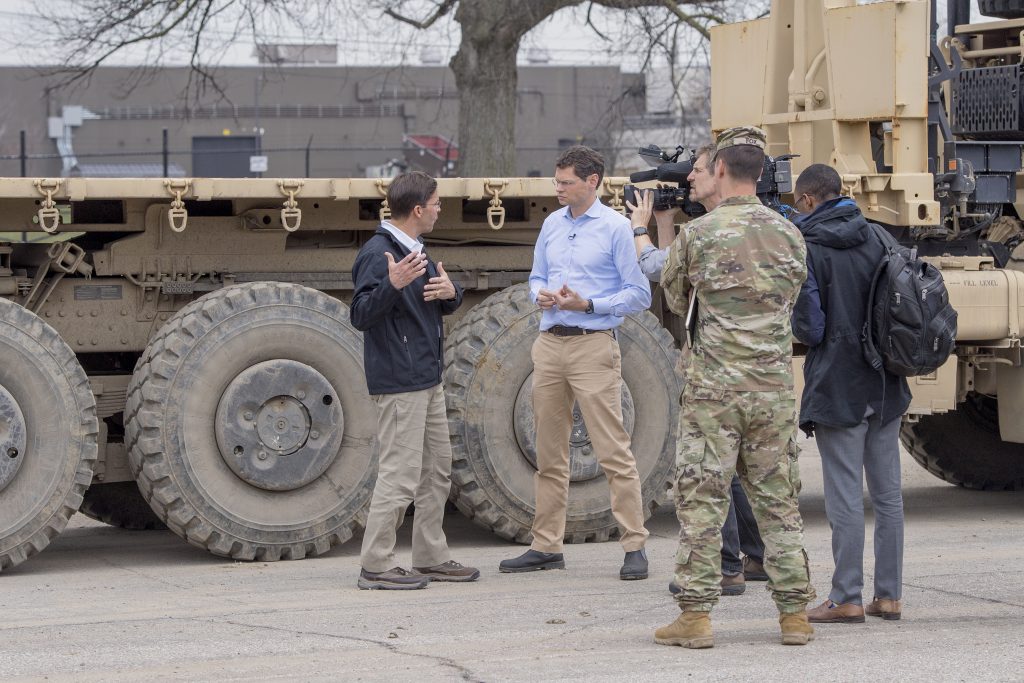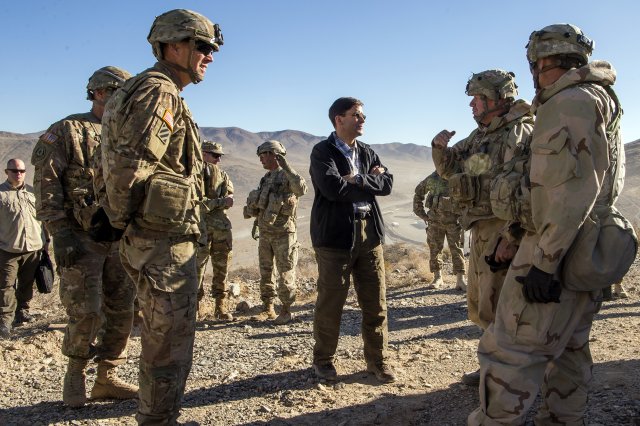By SYDNEY J. FREEDBERG JR
 PENTAGON: When Army Futures Command stands up this summer, it won’t just be a new organization. It’ll embody a new way of organizing — and reorganizing, and reorganizing again. The goal, Army Secretary Mark Esper told me in an exclusive interview, is to keep adapting to new challenges in a way that, while alien to the federal government, is common to both frontline Army units and the private sector. A Marxist might call this “permanent revolution.” Esper’s agenda isn’t quite so radical, though: Call it “permanent evolution.” It’s about getting comfortable with change. That’s something Pentagon bureaucracies generally don’t handle well. Organizations created to drive change — the Office of Force Transformation under Art Cebrowksi, the Strategic Capabilities Office under Will Roper — can make an impact for a time but often wither when they lose their original, visionary leader, their high-level patron, or both. Organizations that endure often become as hidebound as the old order they replaced. So how can the Army ensure Futures Command succeeds?
PENTAGON: When Army Futures Command stands up this summer, it won’t just be a new organization. It’ll embody a new way of organizing — and reorganizing, and reorganizing again. The goal, Army Secretary Mark Esper told me in an exclusive interview, is to keep adapting to new challenges in a way that, while alien to the federal government, is common to both frontline Army units and the private sector. A Marxist might call this “permanent revolution.” Esper’s agenda isn’t quite so radical, though: Call it “permanent evolution.” It’s about getting comfortable with change. That’s something Pentagon bureaucracies generally don’t handle well. Organizations created to drive change — the Office of Force Transformation under Art Cebrowksi, the Strategic Capabilities Office under Will Roper — can make an impact for a time but often wither when they lose their original, visionary leader, their high-level patron, or both. Organizations that endure often become as hidebound as the old order they replaced. So how can the Army ensure Futures Command succeeds?
First do no harm, Esper told me when we sat down in his Pentagon office last week. “We’re not going to migrate bad practices into Army Future Command,” he said, however time-honored those practices are in the institutional Army. “We won’t create layer upon layer, you know, the traditional councils of colonels and general officers’ steering committee and this level and that level. It’ll be a much leaner type of organization.”
But org charts aren’t the solution, Esper said: Leadership is. “The key thing is getting the commander right,” he told me. “Part of what we want to do is make sure the commander can put his touch on that and figure out the best way to optimize this organization. So we have a game plan, we have a developing organizational chart, but at the end of the day the commander and the command will have to learn what is the best way to wire this thing, to operate, and to ensure that it’s effective as possible.”
“We have to be willing to operate in the grey for some period of time until we find out what works best,” Esper said. “We experiment, we try, and we learn.”
Army Futures Command will be especially in flux for its first year, between Initial Operational Capability (IOC) this summer and Full Operating Command (FOC) next year. But even after that, Esper said, it needs to keep adapting in a way Army bureaucracies traditionally have not.
“I’m not a carved in stone type of person. I think you have to remain flexible to react to what happens in the environment,” Esper said. “It’s probably fair to say, by next summer, we should have worked out a great deal…. And over time, you want to continue to refine and make changes…. so the concrete never really hardens.”
“That’s kind of my approach and that would be my direction to the commander as well,” Esper said. “You’ve got to remain open to change, you’ve got to remain flexible, you’ve to remain accessible. That is the purpose of this command.”

Army Secretary Mark Esper (left) getting briefed on a self-driving “leader-follower” autonomous vehicle (in background).
How can Army Futures Command stay flexible? Esper draws lessons from the two worlds he’s worked in beside the Army: Capitol Hill and the private sector.
“Hill offices, committees are generally flat, so you see a lot of efficiency,” said Esper, who’s worked in both the House and Senate. “They can move quickly. You have great access to the boss.” That insight militates against the traditional layers upon layers of federal bureaucracy and Army commands.
Then, Esper continued, “in the private sector, you see a lot of matrixed organizations.” In traditional bureaucratic or, for that matter, military organizations, everyone working in a given unit or activity reports to one boss, who reports to his boss, who reports to another boss, on up the chain. That structure makes who’s in charge very clear but complicates collaboration on projects that cut across these vertical “stovepipes.” By contrast, some 84 percent of American workers now belong to matrixed organizations, in which they report to two bosses for different purposes — say the head of R&D and the regional manager for New York — and each boss can pull on talent from multiple parts of the company. This eases collaboration at the potential cost of clarity.
Training & Doctrine Command headquarters on Fort Eustis, Virginia. Much of TRADOC’s responsibilities for envisioning the future of the Army will move to the new Futures Command.
What parts of Army Futures Command will be matrixed? While the full org chart isn’t yet final, at least one crucial element of the command will definitely have a dual reporting relationship. The Program Executive Officers and subordinate Product Managers who actually contract for, develop, and acquire weapons systems will report to the general running Futures Command, but by law they must still report to the civilian Service Acquisition Executive. The Cross Functional Teamsthe Army has already created to work on its Big Six modernization priorities are also matrixed to a degree, since they bring together representatives from multiple organizations to coordinate their operations under a one or two-star commander.
Smoothly performing matrixed organizations “are very comfortable and very practiced in working horizontally and vertically and are very practiced in working amongst changing teams based on the problem in front of you,” Esper said. “I think that’s something we have to become very nimble at.”
But government has tried matrixed organizations before, I argued, with distinctly mixed results. And don’t matrixes confuse the chain of command in a way that’s distinctly uncomfortable for the military?
Not at all, argued Esper, who himself has served in the regular Army, National Guard, and Reserve. “It’s not unusual for Army leaders in a tactical environment to work for more than one commander. We have that all the time. What we do is OPCON units.” Army units reorganize in the field all the time, what’s called “task-organization”: For example, a tank battalion that needs to operate in a city may get additional infantry from an infantry battalion. While a transferred unit may still report to its original commander on matters of personnel, equipment, training, and so on — Administrative Control or ADCON — it gets its missions and operational orders from whoever has Operational Control, or OPCON.
Army Futures Command needs to show the same kind of flexibility, Esper argued. “You always have some folks that wrestle with that type of structure,” he said. “It’s actually not a new thing, in many ways, to the tactical Army, but it is something we have to, again, adopt, embrace, and become comfortable with in the institutionalArmy.”

Army Secretary Mark Esper speaks to soldiers at the National Training Center on Fort Irwin, California
Jointness and Multi-Domain
Esper wants to improve coordination not only within the Army but between the Army and the other services. He, Navy Secretary Richard Spencer, and Air Force Secretary Heather Wilson now meet every few weeks — without staff — to discuss ways to work together, especially by combining their efforts on R&D.
“I think setting the example goes a long way in terms of building cooperation between the services,” Esper said of the three secretaries’ “breakfast club.”
In particular, “Sec. Wilson, Sec. Spencer and I are fully aligned in terms of the need to further cooperate on building multi-domain operations,” Esper said. “We all see that as the future. That’s the way to go…..We’ve had that discussion in meetings larger than the three of us, with the Secretary (of Defense, Jim Mattis).”
Traditional jointness calls for the services to split up the world so they don’t get in each other’s way: Army takes the land and enough airspace above for helicopters, the Navy takes the sea and divides airspace with the Air Force, and so on. But the emerging concept various called multi-domain operations, multi-domain battle, or multi-domain command and control — depending on who’s talking — calls for the services to operate beyond their traditional domains. The Army, for example, could launch anti-ship missiles from shore to help the Navy, blitzkrieg anti-aircraft batteries to help the Air Force, or disrupt enemy networks with jamming and cyber attacks.
Much of the move to multi-domain operations is a matter of institutional culture, doctrine, and tactics. But fully realizing the vision will also require new technologies, like anti-ship missiles for the Army. The three service secretaries are coordinating their investments.
“We’ve identified some technologies that are common and important to us all: hypersonics, directed energy, artificial intelligence, robotics,” Esper said. “Those are the areas where we’re talking with the deputy secretary of defense (Patrick Shanahan) and Dr. Mike Griffin (under secretary for research & engineering) about how do we leverage each individual (service’s) work, how do we make sure that we’re cooperating with one another, how does R&E kind of help facilitate that cooperation.”
“We still have our own budgets, we still have our own priorities, but the degree we can cooperate, work together, share our findings, share our research, it allows us all to advance a lot more quickly,” Esper said.
The Army Secretary is acutely conscious that he may be modernizing on borrowed time. “I’m unsure of funding in ’20 and beyond,” he said, when the current budget deal expires and the Budget Control Act, aka sequestration, returns in full force. “While I have two good years,” he said, “I want to use these two good years to work and to find efficiencies to free up as much money as I can.”
Even if the Army cuts lower-priority programs and streamlines services, however, Esper doesn’t see it being enough to insulate the Big Six priorities from a full-scale return of BCA spending caps, he said: “If sequester returns, it will be devastating to our readiness approach, (and) it will certainly affect our modernization plans.”
No comments:
Post a Comment